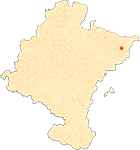Route through the Roncal altarpieces
By Ricardo Fernández Gracia
Altarpiece of the Shrine of Our Lady of Fair Love of Our Lady of San Salvador of Urzainqui
The altarpiece is the work of Francisco Pejón, belonging to a clan of artisans who succeeded each other in three generations, originally from the Aragonese town of Sos del Rey Católico, who worked in Navarre in the second and third quarters of the 18th century. The first of them, Francisco Pejón, the old one, is documented in the late thirties and early forties, between 1737 and 1743, in some localities of the Roncal Valley (Urzainqui, Roncal and Burgui) and Tafalla, and even took his exam in Pamplona to exercise his official document in 1739.
This altarpiece is the first documented work of the master in Roncal and Navarra. The contract for its execution was signed in Roncal on October 8, 1737. The promoters of the work were, in this case, four neighbors of the town commissioned for that purpose, "driven by piety and looking for the greater decency and worship of Mary Most Holy in the basilica called San Salvador of that town, and finding its altarpiece very old and battered, wishing to do it again....". The design for the execution of the altarpiece ran to position of Francisco Pejon himself and, adjusting to it, he carried it out for 3,400 reals, in a deadline that ended in March 1738.
The piece is related to earlier models, although it also presents original features typical of the time in which it was built. The great protagonism is the decoration on Structures and shutters, exquisitely carved with geometric moldings. Its plan is adapted to the head of the temple and in its elevations there is a high sotabanco, a bank with corbels, a single body subdivided in three streets of similar proportions and a curved attic with a shallow shell. The avoluted corbels of the bench incorporate, along with their rich carving, figures of children, two with the coat of arms of the Roncal valley and the other two with tunics; their placement at the front and at profile provide movement to the Structures of the piece. The articulation of the streets of the body is made by Solomonic columns dressed in curly carving and composite capital. A distinctive feature of the master is the cylindrical and curved forms of the entablature dadoes that are related to some Aragonese altarpieces of the time of San Carlos Borromeo in Zaragoza, and the facade of the University of Valladolid, designed by the Carmelite friar Pedro de la Visitación in 1715.
The iconography obeys to particular devotions of the locality. It presents carvings of the same time, with the exception of the titular, which is a medieval image of the XIV century. In the lateral niches San Juan Bautista and San Sebastián appear, the attic is presided by the figure of the Savior, old invocation of the temple, and to its sides the images of San Antonio and San Pedro Nolasco are venerated. The gilding of the whole set was made by Francisco de Ariño and dates from 1741. It was made by the common procedure to ask for alms as it is pointed out in several inscriptions that read: "ESTA OBA. SE A DORO. DE LIMO ESTA OBA. SE ADORO. DE LIMOA EL AÑO DE 1741 FRANCº DE ARIÑO LO DORO". The gold revalues the different parts of the altarpiece, especially all the ornamental ones and besides dignifying the piece has collaborated, as in other cases, to the strengthening of the wood and its conservation.
Parish archives of Garde, Vidángoz, Isaba, Uztárroz and Roncal.
file Diocesan of Pamplona. Processes
file General of Navarre. Roncal Notary's Office and Processes
ARDANAZ IÑARGA, N., La catedral de Pamplona en el siglo de las Luces. Arte, ceremonial y cultura, Pamplona, doctoral dissertation sustained at the University of Navarre, 2011. Vid. http://hdl.handle.net/10171/20480
BOLOQUI LARRAYA, B., Escultura zaragozana en la época de los Ramírez 1710-1780, Madrid, Ministerio de Cultura, 1983.
CHOCARRO HUESA, M., "El obispo Juan Rena, mediador y mecenas artístico de la catedral de Pamplona", Príncipe de Viana, 256 (2012), Issue dedicated to: programs of study sobre el Patrimonio Cultural y las artes en Navarra en torno a tres hitos 1212-1512-1812, (coordinated by Ricardo Fernández Gracia), pp. 587-601.
CLAVERÍA ARANGUA, J., Iconografía y santuarios de la Virgen en Navarra, vol. I, Madrid, Gráfica management assistant, 1942.
ECHEVERRÍA GOÑI, P., Polychromy of the Renaissance in Navarre, Pamplona, Government of Navarre, 1990.
GARCÍA GAÍNZA, M. C., Romanesque sculpture in Navarre. Disciples and followers of Juan de Anchieta, Pamplona, 1969.
GARCÍA GAÍNZA, M. C. et alt., Catalog Monumental de Navarra, IV* y IV**. Merindad de Sangüesa, Pamplona, Government of Navarra - Archbishopric of Pamplona - University of Navarra, 1989 and 1992.
FERNÁNDEZ GRACIA, R., El retablo barroco en Navarra, Pamplona, Government of Navarre, 2003.
FERNÁNDEZ GRACIA, R., "Los géneros escultóricos", El arte del Barroco en Navarra, (coord. R. Fernández Gracia), Pamplona, Gobierno de Navarra, 2014, pp. 175-271.
GÁRRIZ, J., La villa de Garde en el Valle del Roncal. essay de una monografía parroquial, Pamplona, Casa publishing house de G. Huarte, 1923.
HUALDE, F., "De cuando los Ezquer cruzaron el charco", Diario de Noticias de Navarra, 18 August 2008. http://patrimonionavarra2.blogspot.com.es/2010/09/18-de-agosto-de-2008.html
MORALES SOLCHAGA, E., "El gremio de San José y Santo Tomás de Pamplona hasta el siglo XVII", Príncipe de Viana, no. 239 (2006), pp. 791-860.
URANGA, J. E., Retablos navarros del Renacimiento, Pamplona, Institución Príncipe de Viana, 1947.












